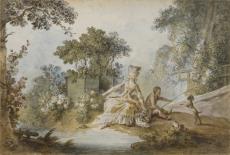


Αυστηρή κριτική άσκησε ο Edmond de Goncourt προς τον Jean-Baptiste Huet, σύμφωνα με την οποία ήταν «ο αντιγραφέας, ο λογοκλόπος των σχεδίων, των μοτίβων, των ίδιων των τεχνικών του Boucher… ας ειπωθεί δυνατά: αυτό που στον Boucher είναι όμορφο, ενέχει κάποτε το μεγαλείο, ενώ στον Huet δεν είναι ποτέ τίποτε παραπάνω από όμορφο»∙ ωστόσο στη συλλογή του de Goncourt περιλαμβάνονταν τουλάχιστον έξι σχέδια του Huet – έναντι 13 του François Boucher (1703-1770), μαζί με ένα ακόμη που του αποδίδεται, αλλά είναι αμφίβολο πως πρόκειται για δική του δημιουργία, καθώς και μία υδατογραφία (το πρώτο απόκτημα των αδελφών Goncourt) που πιθανότατα είναι έργο του Huet. Ενδεχομένως, μπορεί να έχει κάποια ιδιαίτερη σημασία το γεγονός ότι όλα αυτά τα έργα αποκτήθηκαν κατά τη διάρκεια της ζωής του Jules de Goncourt. Δεν υπάρχει αμφιβολία πως ο Huet ήταν ο πιο πιστός μιμητής του Boucher – αν και δεν υπήρξε ποτέ μαθητής του. Όμως με την πάροδο του χρόνου ανέπτυξε τόσο ένα προσωπικό ύφος όσο και μια δική του τεχνική, μολονότι ένα από τα βασικά είδη ζωγραφικής στο οποίο αφοσιώθηκε, η απόδοση βουκολικών θεμάτων, κατεξοχήν ταυτίζεται με τον Boucher. Εντούτοις διέθετε μια ιδιαίτερη άνεση στην απεικόνιση ζωικών μορφών. Εφάρμοσε την τεχνική της υδατογραφίας – που συχνά θα ήταν πιο ακριβές αν την αποκαλούσαμε «χρωματισμένο σχέδιο»–, καθώς και της γκουάς. Το ύφος εστίαζε περισσότερο στη λεπτομέρεια συγκριτικά με τον Boucher, και θα ήταν δίκαιο να χαρακτηρισθεί, όπως άλλωστε σημείωνε και ο de Goncourt, ως «όμορφο» ή «χαριτωμένο».
Το στυλ αυτό εμφανίζεται για πρώτη φορά στο έργο του Huet στα μέσα της δεκαετίας του 1770 (ένα πρώιμο δείγμα αποτελεί το έργο Βοσκοπούλα και Χωρική Συζητούν σε Τοπίο του 1774· Snite Museum of Art, University of Notre Dame, Notre Dame, Ιντιάνα). Καθοριστική σε αυτήν την καλλιτεχνική του επιλογή ίσως να ήταν η αμείλικτη κριτική που δέχτηκε για την απόπειρά του να δημιουργήσει τη μεγάλων διαστάσεων ιστορική ελαιογραφία Ηρακλής και Ομφάλη (θέση άγνωστη), όταν την παρουσίασε στο Σαλόν του 1779. Όμως εκείνη την εποχή, όχι μόνο συγκέντρωνε γύρω του έναν σημαντικό αριθμό συλλεκτών που ήταν πρόθυμοι να αποκτήσουν τα σχέδια, τις υδατογραφίες και τις γκουάς του –σε βαθμό μάλιστα που δεν ένιωσε καμία ανάγκη να συμμετάσχει στο Σαλόν της χρονιάς που φιλοτεχνήθηκε το έργο της Συλλογής Α. Γ. Λεβέντη–, αλλά συνεργαζόταν και με έναν ταλαντούχο χαράκτη, τον Gilles Demarteau, γνωστό ως Demarteau l’Aîné (1722-1776), που ειδικευόταν στην αναπαραγωγή σχεδίων∙ χάρη στον Gilles, ο Huet είχε τη δυνατότητα να καλύψει τη μεγάλη ζήτηση για τις δημιουργίες του στην αγορά έργων τέχνης. Ο ανιψιός του Gilles, ο GillesAntoine Demarteau (1750-1802), συνέχισε να χαράσσει και να εκδίδει τα έργα του Huet στο ίδιο ύφος, αν και όχι τόσο άρτια, όμως υπήρξαν και πολλοί άλλοι δεξιοτέχνες χαράκτες, όπως οι Louis-Marin Bonnet (1736-1793) και J. Augustin L’Eveillé (χρονολογίες άγνωστες) που αναπαρήγαν τις συνθέσεις του.
Η υδατογραφία της Συλλογής Α. Γ. Λεβέντη συνιστά ένα γοητευτικό δείγμα των ικανοτήτων του Huet σε αυτό το πνεύμα. Μοιάζει λίγο ασυνήθιστη αφού, αντί να ζωντανεύσει το τοπίο του με φιγούρες χωρικών και ζώων, ο Huet έχει αποδώσει εκεί μια γυναικεία μορφή ντυμένη σύμφωνα με τη μόδα της εποχής εκείνης, που θα ταίριαζε περισσότερο σε πίνακα που απεικονίζει εσωτερικό χώρο. Παρ’ όλα αυτά, το ψάρεμα ήταν μια αγαπημένη απασχόληση για τις κυρίες της υψηλής κοινωνίας (πιθανόν λόγω αγγλικής επιρροής). Ο Huet μπορεί επίσης να υπαινισσόταν πως οι γυναίκες διαθέτουν και αγκίστρια άλλου είδους, που προορίζονται για ανθρώπινη λεία («[…] γυναίκα-παγίδα, που η καρδιά της είναι δίχτυ και τα χέρια της δεσμά» – από τη μετάφραση της Παλαιάς Διαθήκης της Ελληνικής Βιβλικής Εταιρείας, Εκκλησιαστής, 7:26).
Από μεγάλη οικογένεια καλλιτεχνών, εργάστηκε στο Παρίσι, όπου επιδόθηκε στη ζωγραφική, στη χαρακτική και στο σχέδιο. Επηρεάστηκε καταλυτικά από τον François Boucher και απεικόνισε τοπιογραφίες, βουκολικά θέματα και ηθογραφίες στο ανάλαφρο ύφος του Ροκοκό. Απέδιδε επίσης με ξεχωριστή επιδεξιότητα ζωικές μορφές. Εκτός από τα χαρακτικά του, είναι επίσης γνωστός για τα διακοσμητικά του σχέδια, ιδιαίτερα για εκείνα που προορίζονταν για υφάσματα.